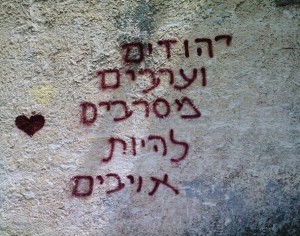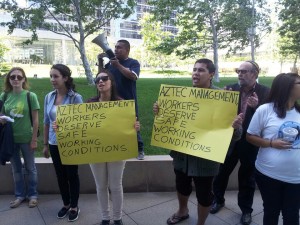Last year good friends visiting from Israel brought as a gift a CD by Gal Ziv, which put to music some wonderful contemporary Israeli poems. One line sticks with me. It is from the poem “Ibn Gvirol, Tammuz, Future Tense” by Tal Nitzan. The poem is sung with a hauntingly beautiful melody. I am assuming that the poem was written around the time of the Israeli tent protests which captured the passions and imaginations and participation of tens of thousands of Israelis in the summer before the Occupy movement started. I hear the words through the filter of Occupy LA.
Coins dive down to the musician’s bag
with the audacity of small change, feet
will wallow in the detritus of the demonstration
what was spoken and shouted will be swept up
life is much stronger*
And I hear the words echoing with the youthful wistfulness of Dylan’s “Visions of Johanna.”
Inside the museums, Infinity goes up on trial
Voices echo this is what salvation must be like after a while
And I hear the words resonating with the fleeting nature of revelation as we move toward Shavuot, when we celebrate the necessary distance between people and God by wallowing in the gift of interpretation, of midrash, of study.
And then, in the very next moment, as we look upon it from the perspective of time past, those same people dance around the Golden Calf. The idolatry that is born of a need for concretized meaning and the intimacy of being able to point to a thing—the incarnation perhaps of a divine desire—and say: “This is your god”, overcomes the experience of revelation. Life is much stronger.
The move from rethinking the way the world might work, in which the space that is created between a people and the divine endlessness of Torah writ large, to the small narrow space of concretized and static deity is almost incomprehensible. How does one, let alone everyone, move from the frenetic liberating energy of infinite possibility to the “audacity of small change” which rings hollowly but can be sighted and pointed at. And yet, it is this move, more than revelation, more than liberation, which seems to define history. The day after, when the street sweepers come through and collect the detritus of passion and revolution, and tourists look at the gated off gardens and parks and plazas where righteous anger brought forth a dream of difference, a vital vision of a more just future—that day after regularly saps our spirits and dampens our drive, giving way to the demons of the day to day: “life is much stronger.”
And yet, we return each year with Sisyphean regularity performing the possibility of redemptive reading, hoping that this year the creative discourse of friends and allies hunched over texts ancient and modern, sacred and secular, profound and profane, will propel us into a future more full with the promise of perfectibility.
The future is still covered in the thick fog. With so much in the balance, perhaps this time when the fog clears it will be the dancing of holy revolutionaries singing the psalms of justice that we will hear.
I’ll see you at the foot of the mountain.
___________
* The translation is mine.


